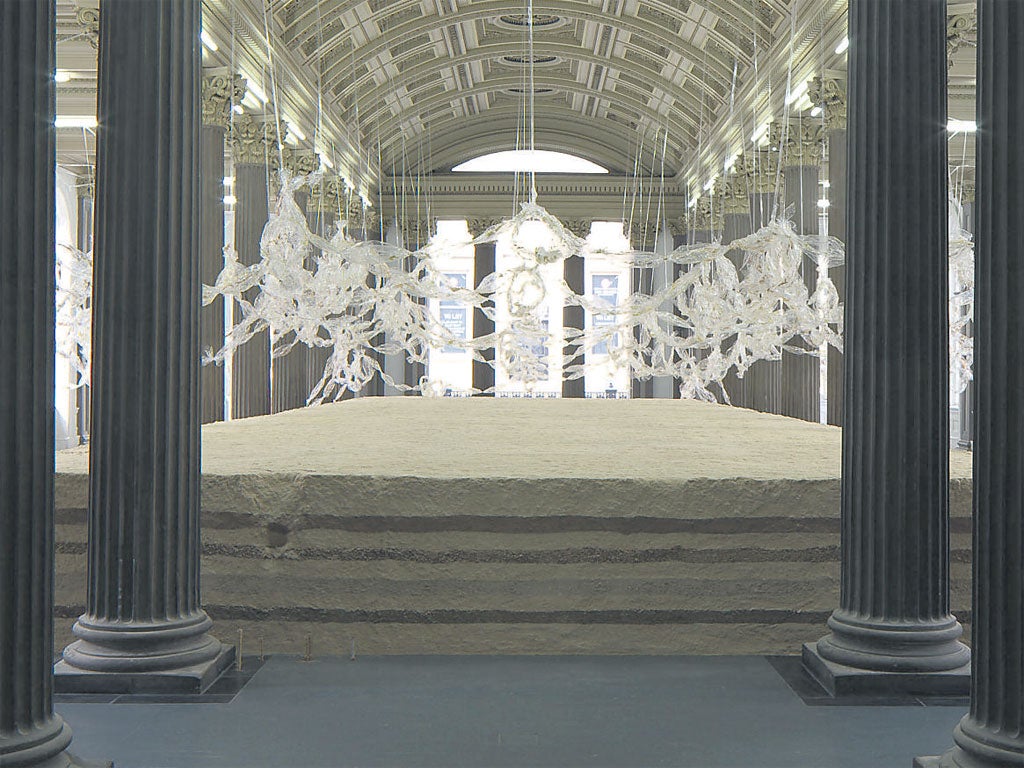Glasgow International Festival of Visual Art, Various venues
The scale of this Scottish art festival makes others look meagre, and the quality of the work is very tasty too

Your support helps us to tell the story
From reproductive rights to climate change to Big Tech, The Independent is on the ground when the story is developing. Whether it's investigating the financials of Elon Musk's pro-Trump PAC or producing our latest documentary, 'The A Word', which shines a light on the American women fighting for reproductive rights, we know how important it is to parse out the facts from the messaging.
At such a critical moment in US history, we need reporters on the ground. Your donation allows us to keep sending journalists to speak to both sides of the story.
The Independent is trusted by Americans across the entire political spectrum. And unlike many other quality news outlets, we choose not to lock Americans out of our reporting and analysis with paywalls. We believe quality journalism should be available to everyone, paid for by those who can afford it.
Your support makes all the difference.The selectors of the every-other-yearly Glasgow International Festival of Visual Art (GI) face an enviable problem. There are too many Glaswegian contemporary artists, and too much of what they do is good. Head for head, the city creatively outperforms any town in Britain. Were London to compete, Hoxton would have to be 10 times as big. The danger for GI selectors is of over-favouring local artists, making the project parochial. The word “International” is there between “Glasgow” and “Festival”, after all, although in the past it has sometimes felt overlooked.
Not this year. True, Karla Black, given the hall of the city's Gallery of Modern Art, is Glaswegian. True, too, that she had intended her vast floor piece – 16 tons of it, 10 paces wide by 20 long – to be made of Scottish sawdust, although this turned out to be impossible. It ended up being made of Scandinavian dust, straight-edged and stratified like a cutaway slice of landscape.
Just to add to its international flavour, a gallery guard suggests that Black's work looks (you should try to hear this in Glaswegian) like tiramisu. It does. Some sides are pristine, some crumbling. Black has demanded that the floor be swept of fallen sawdust every day, an uphill task if tiny Glaswegian hands get near it. Overhead, she has hung Will Attach, a cloudscape swagged in trademark cellophane, descending to child-hand height at the hall's far end. The clouds rain gloopy cosmetics on to a single spot on the floor. It is a health & safety nightmare.
Not so the show by Wolfgang Tillmans at The Common Guild, although you might do your back in bending to see Ursuppe (“Primordial Soup”) which Tillmans has hung, as he will, low to the floor. The image resembles a Monet lilypond: perhaps it's meant to. Anyway, the show is wonderful, Tillmans hiding tiny images on the overlooked edges of doors and windows or on mirrors, or scaling up small, insignificant things to a vast, sacramental scale. The white Spanish onion of Onion looks as if it is in a temple to alliums although it is actually in an industrial onion-slicing machine.
One thing that has made the Glasgow festival more interesting than those in nearby Scottish cities is the dialogue between its various sites. Sometimes this is intentional, sometimes happy coincidence. Rosalind Nashashibi's film – Lovely Young People (Beautiful Supple Bodies) – is shown at 54 Miller Street but was shot in a ballet studio next to the Tramway artspace. The temptation is to compare the work with that of Degas, Nashashibi's subject, like his, being desire rather than dance.
In this case, we look at middle-aged Glaswegians invited off the street by Nashashibi to watch gazelle-like dancers enduring the tortures of the barre – “Gentlemen! Four princes, please!”, “Feet, feet, feet!”. We listen to the murmured comments of the audience – “Aye, they must get vairrry tired doing all that. Imagine if it was your job! ” As with Degas, we are never quite allowed to settle, to decide which of the film's many gazes is our own. I won't spoil the fleeting pay-off, but see this if you can.
And then on to Tramway. Partly because the venue's spaces are so difficult – vast sheds with exposed brick walls and girders – it specialises in what art schools call “cross-disciplinary practice”, straddling dance, theatre, visual arts and so on. This could be irritating, although the current range of shows at Tramway is by no means so. Most literally, The Making of Us is “a collaboration between theatre director Graham Eatough and visual artist Graham Fagen”, although this hardly does justice to a huge space in which visitors will become part of a 17-day drama and a film, shot around five sets including a pay bar, an office, a bedroom and a tree from which an actor will regularly “hang” himself. Gesamtkunstwerk is the word for this – and it might equally be applied to the festival as a whole.
To 7 May
Critic's choice
Archivist or artist? Weigh up the evidence amassed by Hans-Peter Feldmann (right) at the Serpentine Gallery, London (to 5 Jun). Damien Hirst is another who could be accused of just lining up things (be they pills, butterflies or spots). Decide for yourself whether Tate Modern's retrospective (to 9 Sep) is hollow excess or a brilliant meditation on mortality.
Join our commenting forum
Join thought-provoking conversations, follow other Independent readers and see their replies
Comments